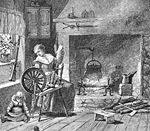
A kitchen is a room or part of a room used for cooking and food preparation in a dwelling or in a commercial establishment. A modern middle-class residential kitchen is typically equipped with a stove, a sink with hot and cold running water, a refrigerator, and worktops and kitchen cabinets arranged according to a modular design. Many households have a microwave oven, a dishwasher, and other electric appliances. The main functions of a kitchen are to store, prepare and cook food. The room or area may also be used for dining, entertaining and laundry. The design and construction of kitchens is a huge market all over the world.
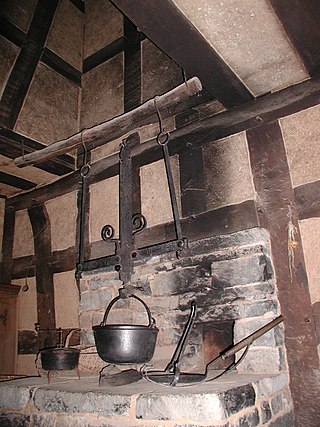
A hearth is the place in a home where a fire is or was traditionally kept for home heating and for cooking, usually constituted by at least a horizontal hearthstone and often enclosed to varying degrees by any combination of reredos, fireplace, oven, smoke hood, or chimney. Hearths are usually composed of masonry such as brick or stone. For centuries, the hearth was such an integral part of a home, usually its central and most important feature, that the concept has been generalized to refer to a homeplace or household, as in the terms "hearth and home" and "keep the home fires burning". In the modern era, since the advent of central heating, hearths are usually less central to most people's daily life because the heating of the home is instead done by a furnace or a heating stove, and cooking is instead done with a kitchen stove/range alongside other home appliances; thus many homes built in the 20th and 21st centuries do not have hearths. Nonetheless, many homes still have hearths, which still help serve the purposes of warmth, cooking, and comfort.
A hobgoblin is a household spirit, appearing in English folklore, once considered helpful, but which since the spread of Christianity has often been considered mischievous. Shakespeare identifies the character of Puck in his A Midsummer Night's Dream as a hobgoblin.

A reredos is a large altarpiece, a screen, or decoration placed behind the altar in a church. It often includes religious images.
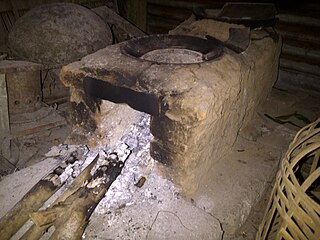
A stove or range is a device that generates heat inside or on top of the device, for local heating or cooking. Stoves can be powered with many fuels, such as electricity, natural gas, gasoline, wood, and coal.

A kitchen stove, often called simply a stove or a cooker, is a kitchen appliance designed for the purpose of cooking food. Kitchen stoves rely on the application of direct heat for the cooking process and may also contain an oven, used for baking. "Cookstoves" are heated by burning wood or charcoal; "gas stoves" are heated by gas; and "electric stoves" by electricity. A stove with a built-in cooktop is also called a range.
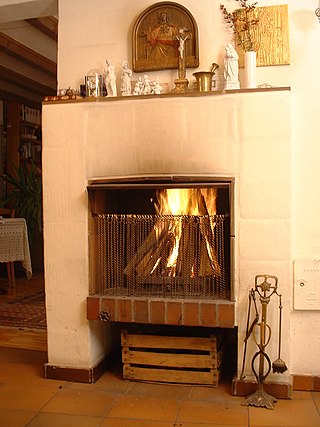
A fireplace or hearth is a structure made of brick, stone or metal designed to contain a fire. Fireplaces are used for the relaxing ambiance they create and for heating a room. Modern fireplaces vary in heat efficiency, depending on the design.

Induction cooking is performed using direct electrical induction heating of cooking vessels, rather than relying on indirect radiation, convection, or thermal conduction. Induction cooking allows high power and very rapid increases in temperature to be achieved: changes in heat settings are instantaneous.
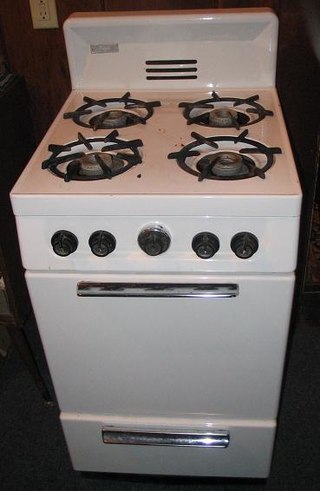
A gas stove is a stove that is fuelled by combustible gas such as syngas, natural gas, propane, butane, liquefied petroleum gas or other flammable gas. Before the advent of gas, cooking stoves relied on solid fuels such as coal or wood. The first gas stoves were developed in the 1820s and a gas stove factory was established in England in 1836. This new cooking technology had the advantage of being easily adjustable and could be turned off when not in use. The gas stove, however, did not become a commercial success until the 1880s, by which time supplies of piped gas were available in cities and large towns in Britain. The stoves became widespread on the European Continent and in the United States in the early 20th century.

An andiron or firedog, fire-dog or fire dog is a bracket support, normally found in pairs, on which logs are laid for burning in an open fireplace, so that air may circulate under the firewood, allowing better burning and less smoke. They generally consist of a tall vertical element at the front, with at least two legs. This stops the logs from rolling out into the room, and may be highly decorative. The other element is one or more low horizontal pieces stretching back and serving to hold the logs off the bottom of the fireplace. An andiron is sometimes called a dog or dog-iron.
Hob, HOB or Hobs may refer to:
The meanings attributed to the word hall have varied over the centuries, as social practices have changed. The word derives from the Old Teutonic (hallâ), where it is associated with the idea of covering or concealing. In modern German it is Halle where it refers to a building but Saal where it refers to a large public room though the distinction is blurred:(Halle ). The latter may arise from a genitive form of the former. The French salle is borrowed from the German.

A cooktop, stovetop or hob, is a device commonly used for cooking that is commonly found in kitchens and used to apply heat to the base of pans or pots. Cooktops are often found integrated with an oven into a kitchen stove but may also be standalone devices. Cooktops are commonly powered by gas or electricity, though oil or other fuels are sometimes used.
Gaggenau Hausgeräte is a German manufacturer of high-end home appliances. The company was established in 1683 as the Eisenwerke Gaggenau A.G. in the Black Forest region of south-west Germany by German aristocrat Louis William, Margrave of Baden-Baden.
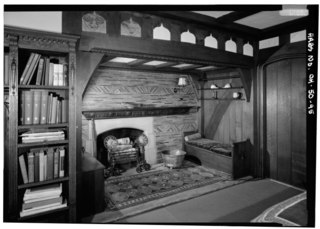
An inglenook or chimney corner is a recess that adjoins a fireplace. The word comes from "ingle", an old Scots word for a domestic fire, and "nook".

The hall house is a type of vernacular house traditional in many parts of England, Wales, Ireland and lowland Scotland, as well as northern Europe, during the Middle Ages, centring on a hall. Usually timber-framed, some high status examples were built in stone.

The Teka Group is a multinational company founded in Germany in 1924 and engaged in the manufacture and commercialisation of kitchen products. It specializes in sinks, exhaust hoods, hobs and ovens. The group has 14 factories in Europe, America and Asia and commercializes its products in 116 countries. The company has a workforce of 4,700 employees worldwide. Its products range from sinks and taps to ovens, induction hobs, extractor hoods and washing machines, among other electrical appliances.

A bachelor griller, mini oven or mini kitchen is a countertop kitchen appliance about the size of a microwave oven but which can instead grill, bake, broil or roast food. It generally incorporates one or two heating elements at the top and bottom of the appliance, has one or two hobs on the cooktop, or a ceramic hotplate, and may incorporate a rotisserie.

Imoinu or Emoinu is a goddess associated with household, hearth, family, fireplace, kitchen, wealth, peace and prosperity in Meitei mythology and religion of Ancient Kangleipak. She is frequently associated with Leimarel Sidabi. She is regarded as one of the incarnations or representations of goddess Leimarel Sidabi.

An agungi is a firebox found in traditional Korean kitchens which is used to burn firewood or other fuel for cooking. It is also a part of the traditional floor heating system, or ondol. The flat cooktop counter or hearth installed over the agungi is called a buttumak (부뚜막).



